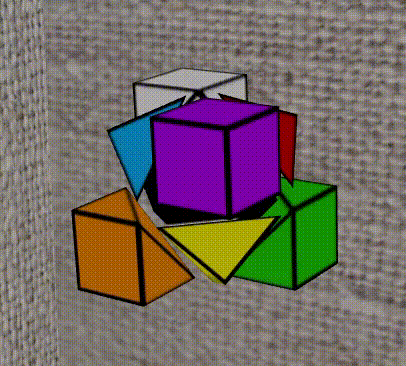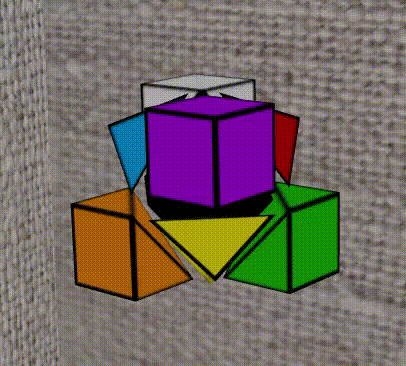I will take the Ring, though I do not know the way.
-- Frodo

The above figure shows a 4D skewb. As a basic implementation, the surrounding cells are not visually distorted. In other words, compared to MC4D, it is less like a perspective projection, but more like a net of the hypercube minus the W+ cell.
So far we discuss the properties of x + y + z + w = 0 cutting hyperplane only. After applying all symmetrical hyperplanes, each cell looks like a Dino cube on its surface, inside which we can see 8 regular tetrahedrons and a regular octahedron in the center. Summing up, there are totally 21 stickers per cell.
I highly suspect there was some previous work that I am not aware of regarding the content in this section. After this series, I will spend some time to go through the MPUlt source code and see how does it handle the symmetry of the 4D skewb puzzle. Yet, this section is the most haunting part for me in this series.
Recall 2x2x2x2. We didn't spend comparable time explaining the cutting cell and properties of the puzzle, because the cuts are naturally fit in 4D cartisien coordinate system and thus intuitive. It is worth considering them before we really starts the bizarre 4D skewb.
What is a cutting cell of a 2x2x2x2 puzzle like? I used statements like "the X+ side of the puzzle" or "the cubie is free because it is free at the W- side of the puzzle". So there must be some cutting cell between, for example, the X- and the X+ side of the puzzle. You may just imagine there are four cutting hyperplanes, each of which has its normal vector being the 4 axes. They are x = 0, y = 0, z = 0, and w = 0.
The player of MC4D doesn't often notice the 4 cutting cell, they are not obvious. Following the similar reasoning process we have done for 4D skewb yesterday, we can make sense out of 2x2x2x2 that the intersections between x = 0 and the net of the hypercube are 6 squares and there are 12 vertices. Yes, it is a cube. Even if it is a 3D object, we cannot directly see it unless we "fold" it. Note that, it looks like that the only cube-like thing between X- and X+ cell is W-, but don't mess up the concept of the cutting cube and the center cell. The former is a cutting cell but the later are merely a set of stickers.
How did we twist a part of the 2x2x2x2 puzzle across the cutting cube? We were able to twist X+ cell around X-/Y-/Z-axis. What about the twists for a 4D skewb?
What's wrong with following the same way to twist 4D skewb? That is, twist the the normalized X-/Y-/Z- axis of the cutting octahedron. It is straightforward and makes sense. Consider the 3D anology,
And then the 4D,
The gap between 1 rotation axis in 3D against a cutting surface and 3 rotation axes in 4D against a cutting cell can be confusing. My mental model for this is that, the only way a surface (a 2D object) can freely rotate about a given axis is limited to X-Y rotation transformation; while a 3D object can "float" in the space and still perpendicular to the given axis, and the floating can always be decomposed to X-Y, X-Z, and Y-Z rotation transformations, so it becomes 3.
Let's be more specific: what are the rays we are talking about here? Recall the 6 vertices, categorized into 3 pairs,
The cutting octahedron animation clip was after normalization the 3 rays defined by the above 3 pairs of vertices into X-/Y-/Z-axis. Since 3D visualization is nature to us human beings, it should now be easy for the reader to imagine how to "twist" the octahedron around these three axis, as the following clip,

Note that the symmetry comes into play now. For example, in the clip we do a 180-degree counterclockwise Y-axis-twist to the octahedron. A valid twist cannot stop after only a 90-degree twist, otherwise the puzzle cannot stay a hypercube shape. Each boundary cell is not a cube given only 90-degree twist. The same limitation applies for 3D skewb. The rotational symmetry of its cutting regular hexagon is 6, so the hexagon itself can fit itself after a 60-degree twist, but it would be just a temporary state of a 3D skewb: at this stage, a corner piece of the twisted part is adjacent to a center piece of the still part and vice versa. The real rotational symmetry for the cutting regular hexagon is thus only 3.
It naturally follows that, for each axis of the octahedron, the avalable twists are
Astonishingly, while the above derivation is intuitive and beautiful, it doesn't tell the full story.
Soon we can notice that the above approach looks limited. For example, the nearest vertex in the following figure can only go to two positions: where it is currently and the farest vertex. it is a little bit weird given that a octahedron is such a symmetrical obeject. There is no reason that we can not rotate any of the faces 120 degrees, which keeps the shape of the hyperplane. As in the clip, first the whole puzzle rotates around the orange one, and then the pink one.
The rotation is not handled very well... I will have to check the matrix I derived if later I need similar demos more seriously.

That is to say, after this refinement, the available twists are
There are 8 triangles but we list only four here because other 4 triangles are reflectionally identical to the above 4.
We close the qualitative discussion about 4D skewb today. Now we understand the cutting octahedron well enough, so that defining the puzzle will be straightforward in the coming days. Personally, it is a relief that I can finally organize my previously random thoughts into this article. From now on, I can focus on implement the puzzle and solve it later.
結束 4D skewb 的定性描述。
